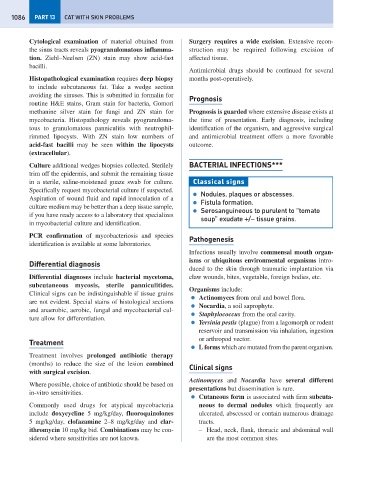Page 1094 - Problem-Based Feline Medicine
P. 1094
1086 PART 13 CAT WITH SKIN PROBLEMS
Cytological examination of material obtained from Surgery requires a wide excision. Extensive recon-
the sinus tracts reveals pyogranulomatous inflamma- struction may be required following excision of
tion. Ziehl–Neelsen (ZN) stain may show acid-fast affected tissue.
bacilli.
Antimicrobial drugs should be continued for several
Histopathological examination requires deep biopsy months post-operatively.
to include subcutaneous fat. Take a wedge section
avoiding the sinuses. This is submitted in formalin for
Prognosis
routine H&E stains, Gram stain for bacteria, Gomori
methanine silver stain for fungi and ZN stain for Prognosis is guarded where extensive disease exists at
mycobacteria. Histopathology reveals pyogranuloma- the time of presentation. Early diagnosis, including
tous to granulomatous panniculitis with neutrophil- identification of the organism, and aggressive surgical
rimmed lipocysts. With ZN stain low numbers of and antimicrobial treatment offers a more favorable
acid-fast bacilli may be seen within the lipocysts outcome.
(extracellular).
Culture additional wedges biopsies collected. Sterilely BACTERIAL INFECTIONS***
trim off the epidermis, and submit the remaining tissue
in a sterile, saline-moistened guaze swab for culture. Classical signs
Specifically request mycobacterial culture if suspected.
● Nodules, plaques or abscesses.
Aspiration of wound fluid and rapid innoculation of a
● Fistula formation.
culture medium may be better than a deep tissue sample,
● Serosanguineous to purulent to “tomato
if you have ready access to a laboratory that specializes
soup” exudate +/- tissue grains.
in mycobacterial culture and identification.
PCR confirmation of mycobacteriosis and species
Pathogenesis
identification is available at some laboratories.
Infections usually involve commensal mouth organ-
isms or ubiquitous environmental organisms intro-
Differential diagnosis
duced to the skin through traumatic implantation via
Differential diagnoses include bacterial mycetoma, claw wounds, bites, vegetable, foreign bodies, etc.
subcutaneous mycosis, sterile panniculitides.
Organisms include:
Clinical signs can be indistinguishable if tissue grains
● Actinomyces from oral and bowel flora.
are not evident. Special stains of histological sections
● Nocardia, a soil saprophyte.
and anaerobic, aerobic, fungal and mycobacterial cul-
● Staphylococcus from the oral cavity.
ture allow for differentiation.
● Yersinia pestis (plague) from a lagomorph or rodent
reservoir and transmission via inhalation, ingestion
or arthropod vector.
Treatment
● L forms which are mutated from the parent organism.
Treatment involves prolonged antibiotic therapy
(months) to reduce the size of the lesion combined
Clinical signs
with surgical excision.
Actinomyces and Nocardia have several different
Where possible, choice of antibiotic should be based on
presentations but dissemination is rare.
in-vitro sensitivities.
● Cutaneous form is associated with firm subcuta-
Commonly used drugs for atypical mycobacteria neous to dermal nodules which frequently are
include doxycycline 5 mg/kg/day, fluoroquinolones ulcerated, abscessed or contain numerous drainage
5 mg/kg/day, clofazamine 2–8 mg/kg/day and clar- tracts.
ithromycin 10 mg/kg bid. Combinations may be con- – Head, neck, flank, thoracic and abdominal wall
sidered where sensitivities are not known. are the most common sites.

